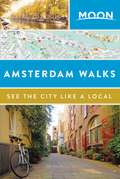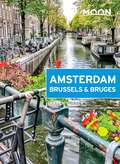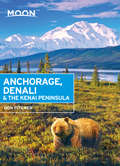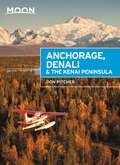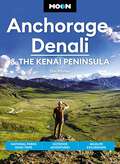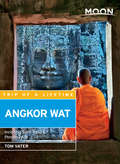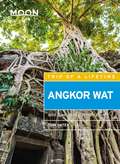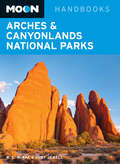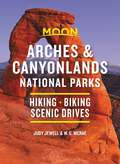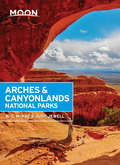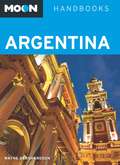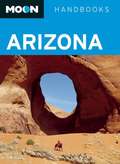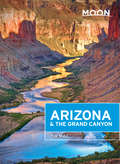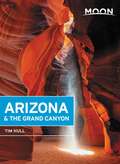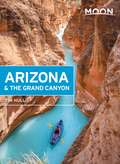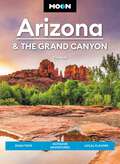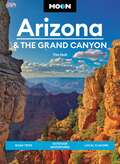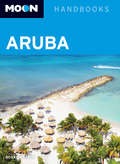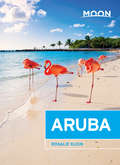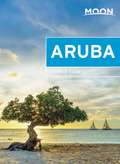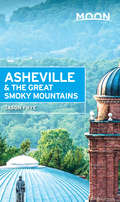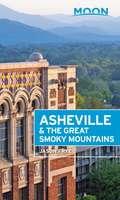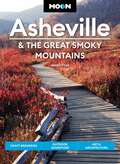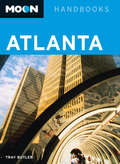- Table View
- List View
Moon Amsterdam Walks (Travel Guide)
by Moon Travel GuidesExperience Amsterdam like a local: on foot! Wander along Amsterdam's sparkling canals and bask in the diversity of its village vibes and cosmopolitan culture with Moon Amsterdam Walks. This full-color guide features: Six customizable walks through the city's hippest neighborhoods, including the Center, Westerpark, the Jordaan, De Pijp, and more, with color-coded stops and turn-by-turn directions; Foldout maps of each route and a removable full-city map, in a handy, portable guide; Curated "Top Ten" lists for restaurants, nightlife, museums, and Sunday activities; The top attractions and the best-kept local secrets: Stroll the canals and admire postmodern architecture, or discover unique boutiques and emerging designers in the buzzing central district. Make like the locals and rent a bike, ride along busy boulevards, and break for a picnic or movie screening at a public park. Explore the city's history in its myriad museums, or peruse contemporary art exhibits in industrial-style galleries. Sip craft beer at a traditional brewery, or artisanal coffee at an outdoor café. Sample seasonal dishes at a trendy farm-to-table restaurant, and dance the night away to DJ sets at the city's hippest nightclubs; Public transportation options, including bike rentals, tram or metro, and ferry; Practical tips for first-time visitors, including average costs, where you'll need to make a reservation, public holidays, and getting to and from the airport. With creative routes, public transit options, and a full-city map, you can explore Amsterdam at your own pace, without missing a beat.
Moon Amsterdam Walks (Travel Guide)
by Moon Travel GuidesWander along Amsterdam's sparkling canals, soak up the village vibes and cosmopolitan culture, and experience Amsterdam like a local: on foot!Walk through the city's coolest neighborhoods like the Center, Westerpark, the Jordaan, De Pijp, and more, with color-coded stops and turn-by-turn directionsFind your scene with top ten lists for restaurants, nightlife, museums, and moreGet to know the real Amsterdam: Stroll the canals and admire postmodern architecture or peruse unique boutiques in the buzzing central district. Make like a local and rent a bike, ride along busy boulevards, and break for a picnic at a public park. Sip a tripel or witbier at a traditional brewery or artisanal coffee at an outdoor café. Uncover the city's history in its many museums or check out contemporary art exhibits in industrial-style galleries. Feast on a farm-to-table spread at a trendy restaurant and dance the night away to DJ sets at the city's popular nightclubsEscape the crowds at locally-loved spots and under-the-radar favoritesExplore on the go with foldout maps of each route and a removable full-city map, all in a handy guide that fits in your pocketWith creative routes, public transit options, and a full-city map, you can experience Amsterdam at your own pace without missing a beat.Hit the ground running with more Walks guides, like Moon Barcelona Walks, Moon Berlin Walks, Moon New York City Walks, Moon London Walks, Moon Paris Walks, and Moon Rome Walks.
Moon Amsterdam, Brussels & Bruges (Travel Guide)
by Karen TurnerExperience the scenic canals, colorful markets, and medieval history of the top cities in Belgium and the Netherlands. Inside Moon Amsterdam, Brussels & Bruges you'll find:Flexible itineraries for 1 to 5 days in Amsterdam, Brussels, and Bruges that can be combined into a longer tripStrategic advice for foodies, art lovers, history buffs, and moreTop experiences and unique highlights: Cyclealong serene canals and narrow brick roads past baroque architecture, or stroll through Bruges's grand Markt Square. Marvel at the works of famed Dutch and Flemish painters, walk through history at the Anne Frank House, or remember the fallen in the cemeteries and memorials of YpresThe best local flavors: Sip on Amsterdam's specialty liquor at a jenever tasting room, or enjoy a glass of authentic Trappist beer produced in monasteries. Snack on Belgian frites, sample stroopwafel, and savor scrumptious local chocolatesIdeas for side trips from each city, including Lisse, The Hague, Rotterdam, and moreExpert insight from Karen Turner, an expat who's called the Netherlands home for yearsFull-color photos and detailed maps throughoutHelpful resources on COVID-19 and traveling to Amsterdam, Brussels, and BrugesBackground information on the landscape, history, and cultural customs of each cityHandy tools such as visa information, Dutch, Flemish, and French phrasebooks, and tips for seniors, LGBTQ+ travelers, visitors with children, and moreExperience the best of these three cities at your own pace with Moon Amsterdam, Brussels & Bruges.Exploring more of Europe's best cities? Check out Moon Rome, Florence & Venice or Moon Prague, Vienna & Budapest. About Moon Travel Guides: Moon was founded in 1973 to empower independent, active, and conscious travel. We prioritize local businesses, outdoor recreation, and traveling strategically and sustainably. Moon Travel Guides are written by local, expert authors with great stories to tell—and they can't wait to share their favorite places with you.For more inspiration, follow @moonguides on social media.
Moon Anchorage, Denali & the Kenai Peninsula
by Don PitcherIn this full-color guide, seasoned travel writer Don Pitcher shares the best ways to experience all that Anchorage, Denali, and the Kenai Peninsula have to offer, from Anchorage Museum's fascinating exhibits to the natural splendor of Denali National Park to Resurrection Bay's breathtaking wildlife tours. Pitcher leads travelers to the highlights of the three areas, offering tips on how to make an Anchorage stay enjoyable and affordable, what to bring on a trip to Denali, and which of the Kenai Peninsula's many outdoor recreational opportunities shouldn't be passed up. Complete with information on taking a boat trip to Portage Glacier, stepping into the past in old mining town Hope, and watching for belugas and bore tides on Turnagain Arm, Moon Anchorage, Denali & the Kenai Peninsula gives travelers the tools they need to create a more personal and memorable experience.
Moon Anchorage, Denali & the Kenai Peninsula (Travel Guide)
by Don PitcherExcitement awaits on the Last Frontier: make your way through Alaska's mountains, glaciers, and rivers with Moon Anchorage, Denali & the Kenai Peninsula. Inside you'll find:Flexible, strategic itineraries, including five days in Anchorage, a weekend in Denali National Park, day cruises, and a two-week adventure covering the whole regionUnique ideas for outdoor adventurers, wildlife enthusiasts, budget travelers, and moreMust-see highlights and offbeat experiences: Embark on a cruise to admire stunning fjords and watch brown bears catch wild salmon out of a river. Go snowboarding at a mountain resort or hike through alpine forests. Dine on fresh king crab at the best restaurants in Anchorage or catch your own halibut on a fishing expedition. Take an intrepid "flightseeing" tour to secluded glacier landings in Denali National Park and discover the best spots to watch the northern lights dance across the skyWhen to go and where to stay from local author and Alaska expert Don PitcherFull-color, vibrant photos and detailed maps throughoutThorough information including background on the landscape, climate, wildlife, and local cultureHelpful resources like emergency services, transportation and wilderness safety tips, and advice for LGBTQ+ travelers, visitors with children, seniors, and moreWith Moon Anchorage, Denali & the Kenai Peninsula's expert advice and local insight, you can plan your trip your way.Expanding your trip? Check out Moon Alaska.
Moon Anchorage, Denali & the Kenai Peninsula: National Parks Road Trips, Outdoor Adventures, Wildlife Excursions (Travel Guide)
by Don PitcherAdventure awaits on the Last Frontier: make your way through Alaska's mountains, glaciers, and rivers with Moon Anchorage, Denali & the Kenai Peninsula. Inside you'll find:Flexible itineraries including four days in Anchorage, four days in Denali National Park, day cruises, and a 10-day adventure covering the best of the Kenai Peninsula Strategic advice for hikers, adventure sports lovers, wildlife enthusiasts, budget travelers, and more Must-see highlights and outdoor experiences: Embark on a cruise to admire stunning fjords and watch brown bears catch wild salmon from a river. Go skiing at a mountain resort or hike through alpine forests. Dine on fresh king crab at the best restaurants in Anchorage or catch your own halibut on a fishing expedition. Take an intrepid "flightseeing" tour to secluded glacier landings in Denali National Park and discover the best spots to watch the northern lights dance across the sky Expert advice from Homer local Don Pitcher on when to go, where to stay, and how to get around Full-color photos and detailed maps throughoutThorough background on the landscape, wildlife, history, and local culture, plus up-to-date information about health and safety, transportation, and recreation Find your adventure in Anchorage, Denali and the Kenai Peninsula with Moon's expert advice and local insight. Expanding your trip? Check out Moon Alaska. About Moon Travel Guides: Moon was founded in 1973 to empower independent, active, and conscious travel. We prioritize local businesses, outdoor recreation, and traveling strategically and sustainably. Moon Travel Guides are written by local, expert authors with great stories to tell—and they can't wait to share their favorite places with you. For more inspiration, follow @moonguides on social media.
Moon Angkor Wat
by Tom VaterThis full-color guidebook includes vibrant photos and easy-to-use maps to help with trip planning.A group of young monks, their robes a luminous orange, cross the causeway. A stone's throw away, rice paddies and golden temple roofs of Angkor shimmer in the morning sun. Monkeys swing from the trees and elephants stand in the shade nearby, waiting for passengers.This is the trip of a lifetime. It will leave you with a new sense of wonder - and some great stories to share. Expert traveler Tom Vater tells you everything you need to know to make this trip possible in this full-color edition of Moon Angkor Wat: Including Siem Reap & Phnom Penh:How to get there, how long it will take, and where to stop along the way - including information on the cities of Siem Riep, Battambang, and Phnom Penh as well as excursions to remote templesHow to choose the best means of transportation, whether you're traveling by tuk-tuk, taxi, motorbike, or bicycleBackground on authentic cultural experiences, from street food feasts to New Year's celebrations - and where to find themDay-by-day itinerary suggestions
Moon Angkor Wat: With Siem Reap & Phnom Penh (Travel Guide)
by Tom VaterThe ancient temples at Angkor Wat are unlike anything else on earth. Step back in time and take the trip of a lifetime with Moon Angkor Wat. Inside you'll find:Strategic itineraries ranging from one to three days in Angkor to a week exploring the Khmer Empire, with suggestions on the most beautiful (and most secluded) temples to visitTop sights and unique experiences: Explore the sublime forested temple ruins of Angkor, remnants of the ancient Khmer Empire. Marvel at Angkor Wat, the largest religious building in the world, get up close to Angkor Thom's carved bodhisattva, and wander among nearly 100 monuments deep in the jungle at Koh Ker. Immerse yourself in bustling city of Siem Reap, drink thick sweet coffee and sample barbequed meats from street carts in Phnom Penh, and stroll the colorful markets, quiet streets, and funky art galleries of BattambangTips for the best ways to tour the temples to get the most out of this sacred and awe-inspiring siteFocused advice and historical context from documentarian and journalist Tom VaterEssential insight on trip planning, health and safety, reservations, transportation (by tuk-tuk, taxi, motorbike, or bicycle), and accommodations ranging from hotels to homestays with local familiesFull-color photos and detailed maps throughout In-depth coverage of Siem Reap, Angkor and all its temples, Phnom Penh, and excursions to other parts of Cambodia such as Banteay Chhmar, Sambor Prei Kuk, Preah Khan, Koh Ker, Preah Vihear, and BattambangWith Moon Angkor Wat's practical tips and an insider's view on the best things to do and see, you can plan the trip of a lifetime.Exploring more of Asia? Check out Moon Vietnam or Moon Phuket & Ko Samui. Special ebook features:Easily navigate listings with quick searches, plus website links and zoom-in maps and imagesPersonalize your guide by adding notes and bookmarks
Moon Arches & Canyonlands National Parks
by Judy Jewell Bill McraeSeasoned travel guide authors W. C. McRae and Judy Jewell are back with an expanded look at Arches National Park and Canyonlands National Park. Packed with information on local recreation (including hiking, biking, rafting, and more), they provide detailed information on which sights should not be missed as well as how to best enjoy the scenery. From Island in the Sky District to Maze District, from Horseshoe Canyon Unit to the unrivaled beauty of Moab, Moon Arches & Canyonlands National Parks gives travelers the tools they need to create a more personal and memorable experience. This ebook and its features are best experienced on iOS or Android devices and the Kindle Fire.
Moon Arches & Canyonlands National Parks: Hiking, Biking, Scenic Drives (Travel Guide)
by Judy Jewell W. C. McRaeForge your own path through the rock arches, canyon-carving rivers, and ever-present ancient cultures of Southeastern Utah with Moon Arches & Canyonlands National Parks. Inside you'll find:Flexible Itineraries: Unique and adventure-packed ideas for day trips to each park, road trips, and moreThe Best Hikes in Arches and Canyonlands National Parks: Detailed trail descriptions, mileage and elevation gains, and backpacking optionsExperience the Outdoors: Climb dramatic stone bridges and slickrock bluffs to Delicate Arch, and find the perfect spot for a red rock photo-op. Join a ranger-led hike through Arches' Fiery Furnace, or a half-day rafting tour down the Colorado River. Hike to mesa-top vistas, mountain bike through high-desert canyons, and explore countless backcountry trails. Visit the Ancestral Puebloan preservation at Hovenweep National Monument, and enjoy a couple microbrews with mountain biking locals in MoabHow to Get There: Up-to-date information on gateway towns, park entrances, park fees, and toursWhere to Stay: Spend a night in a riverfront lodge, or sleep under the stars with campgrounds, resorts, and more both inside and outside the parkPlanning Tips: When to go, what to pack, safety information, and how to avoid the crowds, with full-color photos and easy-to-use maps throughoutExpertise and know-how from seasoned explorers W.C. McRae and Judy JewellFind your adventure with Moon Arches & Canyonlands National Parks.Exploring more of Utah's natural wonders? Try Moon Zion & Bryce. For full coverage of America's national parks, check out Moon USA National Parks: The Complete Guide to All 62 National Parks. About Moon Travel Guides: Moon was founded in 1973 to empower independent, active, and conscious travel. We prioritize local businesses, outdoor recreation, and traveling strategically and sustainably. Moon Travel Guides are written by local, expert authors with great stories to tell—and they can't wait to share their favorite places with you.For more inspiration, follow @moonguides on social media.
Moon Arches & Canyonlands National Parks: With Zion, Bryce Canyon, Arches, Capitol Reef & Canyonlands National Parks (Travel Guide)
by W. C. Mcrae Judy JewellMoon Travel Guides: Find Your Adventure!Forge your own path through the rock arches, canyon-carving rivers, and ever-present ancient cultures of Southeastern Utah with Moon Arches & Canyonlands National Parks.Moon Arches & Canyonlands National Parks features:Full coverage of both national parks and their surrounding areas, with chapters covering Arches National Park, Canyonlands National Park, Moab, and the Southeastern CornerFull-color, vibrant photos and detailed maps throughoutItineraries for every timeline and budget, ranging from one day in each park to a week-long trip covering both, including the best ways to avoid the crowdsThe top activities and unique ideas for exploring each park: Climb dramatic stone bridges and slickrock bluffs to Delicate Arch, and find the perfect spot for a red rock photo-op. Join a ranger-led hike through Arches' Fiery Furnace, or a half-day rafting tour down the Colorado River. Hike to mesa-top vistas, mountain bike through high-desert canyons, and explore countless backcountry trails. Visit the Ancestral Puebloan preservation at Hovenweep National Monument, and enjoy a couple microbrews with mountain biking locals in MoabStrategies for getting to both parks and traveling between themHonest advice on when to go, what to pack, and where to stay inside and outside the park, including the best places to pitch a tent, park your RV, or relax at a B&BCoverage of gateway cities and towns, including Bluff and MoabUp-to-date information on park fees, passes, and reservationsExpert tips from seasoned explorers W.C. McRae and Judy Jewell for travelers looking to go hiking, biking, climbing, rafting, and more, plus essential health and safety informationDetailed hike descriptions with individual trail maps, marked with duration, elevation change, and effortRecommendations for families, LGBTQ+ travelers, seniors, international visitors, travelers with disabilities, and traveling with petsThorough background on the wildlife, terrain, culture, and historyWith Moon Arches & Canyonlands National Parks' curated advice, myriad activities, and expert insight, you can explore the parks your way.Exploring more of North America's national parks? Try Moon Yellowstone & Grand Teton, Moon Rocky Mountain National Park, or Moon Glacier National Park. Exploring more of Utah's natural wonders? Try Moon Zion & Bryce.
Moon Argentina
by Wayne BernhardsonSouth America expert Wayne Bernhardson gives readers his unique perspective on Argentina, from hiking in the Parque Nacional Tierra del Fuego to viewing wildlife among the lagoons of Esteros del Iberá. Bernhardson provides suggestions for great trip strategies, such as the 21-Day Natural History Tour and 15 Days of Argentine Art and Architecture. Moon Argentina is complete with tips on exploring historic sites like Plaza de Mayo and the pre-Columbian ruins of Quilmes.
Moon Arizona
by Tim HullFreelance writer and news reporter Tim Hull offers up the best of Arizona, from rafting down the Colorado River to exploring the art galleries of Sedona. Tim includes creative trip strategies, such as Driving the History of Arizona and Feel the Heat: A Romantic Summer Weekend in Phoenix. As an Arizona native, Tim guides travelers to the Grand Canyon State's best-kept secrets, including "sky islands," small woodlands found on mountain ranges in the Sonoran desert. Explore Red Rock Country, visit the Navajo Nation, and hike in the Grand Canyon-Moon Arizona gives travelers the tools they need to create a more personal and memorable experience.
Moon Arizona & the Grand Canyon
by Tim HullThis full-color guide to Arizona and the Grand Canyon includes vibrant photos and easy-to-use maps to help with trip planning. Moon Arizon & the Grand Canyon gives you the tools to make your own choices, with: Can't-miss sights, activities, restaurants, and accommodations Suggestions on how to plan a trip that's perfect for you, including: The Best of Arizona The Ruins of Lost Cultures A Grand Canyon Family Adventure Top Five Hikes Back to the Old West Scenic Byways 28 detailed and easy-to-use maps The firsthand experience and unique perspective of author Tim Hull
Moon Arizona & the Grand Canyon (Travel Guide)
by Tim HullExplore Arizona's vast open spaces, dreamy canyons, and colorful culture with Moon Arizona & the Grand Canyon. Inside you'll find:Strategic, flexible itineraries from day hikes in the Grand Canyon to a two-week Arizona road trip, designed for outdoor adventurers, history buffs, foodies, and moreCan't-miss highlights and unique experiences: Embark on a multi-day expedition into the depths of the Grand Canyon, discover hidden streams on a hike through high-desert forests, or find the best spots to hit the slopes in winter. Take a scenic drive along historic Route 66, learn about Arizona's ancient native cultures, and stroll charming Old West towns. Explore the red rock cliffs around Sedona, watch your favorite MLB team play during Spring Training, and sample Southwest cuisine from spicy enchiladas to Sonoran hot dogsHow to plan a Grand Canyon adventure, including coverage of towns near gateways to the parkLocal insight from Arizona local Tim Hull on when to go, where to stay, and how to get aroundFull-color photos and detailed maps throughoutFocused coverage of Phoenix, Scottsdale, and the Valley of the Sun, Tucson and Southern Arizona, Flagstaff, Sedona, and Red Rock Country, Navajo and Hopi Country, the White Mountains and the Gila Valley, the Grand Canyon and the Arizona Strip, and the Lower Colorado RiverPractical information including background on Arizona's landscape, climate, wildlife, and culture With Moon Arizona & the Grand Canyon's practical tips and local expertise, you can plan your trip your way.Seeing more of the Southwest? Check out Moon New Mexico or Moon Phoenix. Hitting the road? Try Moon Southwest Road Trip or Moon Route 66 Road Trip.
Moon Arizona & the Grand Canyon (Travel Guide)
by Tim HullExplore Arizona's vast open spaces, dreamy canyons, and colorful culture with Moon Arizona & the Grand Canyon. Inside you'll find:Flexible itineraries from a Grand Canyon adventure to two weeks exploring the whole state, with strategic advice for outdoor adventurers, history buffs, foodies, and moreThe best road trips in Arizona, including historic Route 66, and scenic bywaysThe top hikes, whether you're looking for treks near Phoenix or Tucson, a multi-day expedition into the depths of the Grand Canyon, or hitting the trails in Red Rock Country, complete with distance, duration, difficulty level, and elevation gainCan't-miss highlights and unique experiences: Discover hidden streams on a hike through high-desert forests or find the best spots to hit the slopes in winter. Visit Ancestral Puebloan cliff cities and learn about Arizona's native culture or stroll through charming Old West towns. Marvel at the red rock cliffs around Sedona, watch your favorite MLB team play during Spring Training, and sample Southwest cuisine from spicy enchiladas to Sonoran hot dogsExpert insight from Arizona local Tim Hull on when to go, where to stay, and how to get around, including detailed coverage of gateway cities to the Grand CanyonFull-color photos and detailed maps throughoutPractical information including background on Arizona's landscape, climate, wildlife, and cultureWith Moon Arizona & the Grand Canyon's practical tips and local expertise, you can plan your trip your way.Seeing more of the Southwest? Check out Moon New Mexico or Moon Phoenix, Scottsdale & Sedona. Hitting the road? Try Moon Southwest Road Trip or Moon Route 66 Road Trip.
Moon Arizona & the Grand Canyon: Road Trips, Outdoor Adventures, Local Flavors (Moon U.S. Travel Guide)
by Tim Hull Moon Travel GuidesVast open spaces, dreamy canyons, and colorful culture: experience it all with Moon Arizona & the Grand Canyon. Inside you'll find:Flexible itineraries from a Grand Canyon adventure to two weeks exploring the whole state The best road trips in Arizona, including historic Route 66 and scenic byways The top hikes, whether you're looking for treks near Phoenix or Tucson, a multi-day expedition into the depths of the Grand Canyon, or trails in Red Rock Country, complete with distance, duration, difficulty level, and elevation gain Can't-miss highlights and unique experiences: Discover hidden streams on a hike through high-desert forests or find the best spots to hit the slopes in winter. Visit Ancestral Puebloan cliff cities and learn about Arizona's indigenous cultures or stroll through charming historic towns. Marvel at the red rock cliffs around Sedona, watch your favorite MLB team play during Spring Training, and sample Southwest cuisine from spicy enchiladas to Sonoran hot dogs Expert insight from Arizona local Tim Hull on when to go, where to stay, and how to get around, including detailed coverage of gateway cities to the Grand Canyon and sustainable travel tips Full-color photos and detailed maps throughoutPractical background on Arizona's landscape, climate, wildlife, and culture Find your adventure with Moon Arizona & the Grand Canyon. Seeing more of the Southwest? Check out Moon New Mexico or Moon Phoenix, Scottsdale & Sedona. Hitting the road? Try Moon Southwest Road Trip or Moon Route 66 Road Trip.About Moon Travel Guides: Moon was founded in 1973 to empower independent, active, and conscious travel. We prioritize local businesses, outdoor recreation, and traveling strategically and sustainably. Moon Travel Guides are written by local, expert authors with great stories to tell—and they can't wait to share their favorite places with you. For more inspiration, follow @moonguides on social media.
Moon Arizona & the Grand Canyon: Road Trips, Outdoor Adventures, Local Flavors (Travel Guide)
by Tim HullVast open spaces, dreamy canyons, and colorful culture: experience it all with Moon Arizona & the Grand Canyon. Inside you'll find:Flexible itineraries from a Grand Canyon adventure to two weeks exploring the whole state The best road trips in Arizona, including historic Route 66 and scenic byways The top hikes, whether you're looking for treks near Phoenix or Tucson, a multi-day expedition into the depths of the Grand Canyon, or trails in Red Rock Country, complete with distance, duration, difficulty level, and elevation gain Can't-miss highlights and unique experiences: Discover hidden streams on a hike through high-desert forests or find the best spots to hit the slopes in winter. Visit Ancestral Puebloan cliff cities and learn about Arizona's indigenous cultures or stroll through charming historic towns. Marvel at the red rock cliffs around Sedona, watch your favorite MLB team play during Spring Training, and sample Southwest cuisine from spicy enchiladas to Sonoran hot dogs Expert insight from Arizona local Tim Hull on when to go, where to stay, and how to get around, including detailed coverage of gateway cities to the Grand Canyon and sustainable travel tips Helpful resources on Covid-19 and traveling to Arizona Full-color photos and detailed maps throughoutPractical background on Arizona's landscape, climate, wildlife, and culture Find your adventure with Moon Arizona & the Grand Canyon. Seeing more of the Southwest? Check out Moon New Mexico or Moon Phoenix, Scottsdale & Sedona. Hitting the road? Try Moon Southwest Road Trip or Moon Route 66 Road Trip. About Moon Travel Guides: Moon was founded in 1973 to empower independent, active, and conscious travel. We prioritize local businesses, outdoor recreation, and traveling strategically and sustainably. Moon Travel Guides are written by local, expert authors with great stories to tell—and they can't wait to share their favorite places with you. For more inspiration, follow @moonguides on social media.
Moon Aruba
by Rosalie KleinLongtime resident Rosalie Klein gives travelers an inside look at Aruba, whether they're diving to see Antilla or staying on land and exploring the country's rich heritage and vibrant nightlife. Drawing on over 30 years of experience, Klein offers her expert advice on how to make a stay both memorable and affordable and which of the sights should not be missed-including the Casibari Rock Formation and the Archeological Museum. Complete with information on hiking at Arikok National Park, enjoying a cultural festival in Oranjestad, and watching turtles hatch on Eagle Beach, Moon Aruba gives travelers the tools they need to create a more personal and memorable experience. This ebook and its features are best experienced on iOS or Android devices and the Kindle Fire.
Moon Aruba (Moon Handbooks Ser.)
by Rosalie KleinMake your Escape with Moon Aruba! With its intense blue sea and some of the most stunning beaches in the Caribbean, Aruba is nearly heaven. Find your version of paradise with Moon Aruba.What You'll Find in Moon Aruba:Curated advice from local author Rosalie Klein, who shares her adventurous expertise and love of her adopted countryFull-color, vibrant, helpful photosDetailed directions and maps for exploring on your ownIn-depth coverage of Oranjestad, Eagle Beach and Manchebo Beach, Palm Beach, Malmok, and Noord, North Coast, San Nicolas, Savaneta, and Pos ChiquitoActivities and ideas for every traveler: Go off-roading through the outback, or go snorkeling through the calm turquoise waters. See incredible geological formations and native birds with startlingly bright plumage at Arikok National Park, or experience the festivities of Carnival with the locals. Try local favorites like keshi yena (filled cheese) or cabrito stoba (stewed goat), or taste the freshest ceviche while dining beachfront. Strategic itineraries in an easy-to-navigate format, such as The Best of Aruba, Best Beaches, Explore the Outback, and Best Bets for the Budget-ConsciousCurrent background information on the landscape, culture, history, and environmentEssential insight for travelers on health and safety, recreation, transportation, and accommodations from resorts to beachy bungalows, packaged in a book light enough to fit in your beach bagWith Moon Aruba's practical tips, myriad activities, and an insider's view on the best things to do and see, you can plan your trip your way.Looking for more fun in the Caribbean sun? Check out Moon Jamaica or Moon Dominican Republic.
Moon Aruba (Travel Guide)
by Rosalie KleinWhether you want to dive in and explore a world underwater or just relax on the white sand, paradise is yours with Moon Aruba. Inside you'll find:Strategic itineraries covering the best beaches, the outback, and budget-conscious travel, with ideas for honeymooners, scuba divers, families, and moreThe top activities and unique experiences: Explore geological formations and see birds with startlingly bright plumage at Arikok National Park or celebrate Carnival with the locals. Indulge in traditional favorites like keshi yena (filled cheese) or cabrito stoba (stewed goat) or feast on fresh ceviche while dining beachfrontOutdoor adventures: Go off-roading through the outback, snorkel in turquoise waters, or try your hand at windsurfing or parasailingWays to respectfully engage with culture from local author and dive instructor Rosalie Klein, from supporting small businesses to exploring ethically and sustainably from local author and former dive instructor Rosalie KleinFull-color, vibrant photos and maps throughoutHelpful background on the landscape, culture, history, and environmentHandy tips for health and safety, transportation, LGBTQ travelers, families with children, and moreWith Moon Aruba's practical tips and local perspective, you can experience the best of Aruba.Looking for more fun in the Caribbean sun? Check out Moon Jamaica or Moon Dominican Republic.
Moon Asheville & the Great Smoky Mountains (Travel Guide)
by Jason FryeMake Your Escape with Moon Travel Guides!A community as varied as the landscape it inhabits, and history as wild as the mountains themselves: whether you're a foodie, artist, history buff, or hiker, Moon Asheville & the Great Smoky Mountains helps you plan the perfect trip for you.What You'll Find in Moon Asheville & the Great Smoky Mountains:Local perspective from writer, adventurer, and North Carolina resident Jason FryeExpertly crafted maps and reference photos with detailed directions for getting around on your own, all in an easy-to-navigate formatStrategic itineraries for every trip and budget, including: one day in the Great Smoky Mountains National Park, a five-day mountain getaway, one day in Asheville, and a classic bluegrass and mountain music journeyHonest advice on driving routes, finding the best accommodations from campsites to boutique hotels, and navigating the region like a localActivities and ideas for every traveler: Trek across the scenic hills, meadows, and streams of the Appalachian Trail, or take a dip in the natural hot springs dotting the mountainous terrain. Connect with the region's rich artistic and cultural history, or go whitewater rafting, kayaking, or canoeing. Sample award-winning cuisine and discover the microbreweries that earned Asheville the title of "Beer City USA." Set up camp in the Pisgah National Forest, or find the best local bed and breakfast for a relaxing weekend getawayDetailed and thorough information, including crucial background on culture and history, geography, and plants and wildlifeHandy tools such as emergency resources and tips for hikers and campers, LGBTQ+ travelers, and travelers with disabilitiesWith Moon Asheville & the Great Smoky Mountains' practical tips, myriad activities, and local insight on the best things to do and see, you can plan your trip your way.Seeing the rest of the state? Check out Moon North Carolina. Exploring more of the South? Try Moon Carolinas & Georgia. Looking for more Southern city charm? Try Moon Charleston & Savannah.
Moon Asheville & the Great Smoky Mountains (Travel Guide)
by Jason FryeWhether you're hopping between microbreweries or hiking the Appalachian Trail, get to know this charming Southern hub with Moon Asheville & the Great Smoky Mountains. Inside you'll find:Flexible, strategic itineraries, from a weekend in Asheville to five days in Great Smoky Mountains National Park, designed for outdoor adventurers, foodies, history buffs, and moreThe best local flavor: Indulge in award-winning cuisine on a food tour, discover the microbreweries that earned Asheville the title of "Beer City USA," and catch a live show from a local band. Admire the art deco architecture downtown, gallery-hop in repurposed warehouses, or check out an indie bookstoreUnique outdoor experiences: Hike through the mountains and meadows along the Appalachian Trail, take a dip in the hot springs dotting the hillsides, or break out the binoculars for some top-notch wildlife-watching. Set up camp in the Pisgah National Forest, peep the changing leaves in autumn, or go rafting, kayaking, or canoeing on the French Broad RiverHonest advice on when to go, where to stay, and how to get around from North Carolina local Jason FryeFull-color photos and detailed maps throughoutThorough background on the culture and history, wildlife, and geographyHelpful tips for hikers and campers, LGBTQ+ travelers, and travelers with disabilitiesFind your adventure with Moon Asheville & the Great Smoky Mountains.Exploring more of the South? Try Moon Carolinas & Georgia. Looking for more Southern city charm? Try Moon Charleston & Savannah.
Moon Asheville & the Great Smoky Mountains: Craft Breweries, Outdoor Adventure, Art & Architecture (Travel Guide)
by Jason FryeWhether you're hopping between microbreweries or hiking the Appalachian Trail, get to know this charming Southern hub with Moon Asheville & the Great Smoky Mountains. Inside you'll find:Flexible, strategic itineraries, whether you have a week to explore or just one day, designed for outdoor adventurers, foodies, history buffs, and more The best local flavor: Indulge in award-winning cuisine on a food tour, discover the microbreweries that earned Asheville the title of "Beer City USA," and catch a live show from a local band. Admire the art deco architecture downtown, gallery-hop in repurposed warehouses, or check out an indie bookstore Unique outdoor experiences: Hike through the mountains and meadows along the Appalachian Trail, take a dip in the hot springs dotting the hillsides, or break out the binoculars for some top-notch wildlife-watching. Set up camp in the Pisgah National Forest, peep the changing leaves in autumn, or go rafting, kayaking, or canoeing on the French Broad River Honest advice on when to go, where to stay, and how to get around from North Carolina local Jason Frye Full-color photos and detailed maps throughoutThorough background on the culture and history, wildlife, and geography Find your adventure with Moon Asheville & the Great Smoky Mountains. Expanding your trip? Try Moon North Carolina. Looking for more Southern charm? Try Moon Charleston & Savannah. About Moon Travel Guides: Moon was founded in 1973 to empower independent, active, and conscious travel. We prioritize local businesses, outdoor recreation, and traveling strategically and sustainably. Moon Travel Guides are written by local, expert authors with great stories to tell—and they can't wait to share their favorite places with you. For more inspiration, follow @moonguides on social media.
Moon Atlanta
by Tray ButlerSkilled writer-journalist Tray Butler offers up his best advice on Atlanta-from the bustling financial Downtown district to the historical draw of Sweet Auburn and the fabulous food and arts of Decatur. Butler includes unique trip strategies for a variety of travelers, such as The Two-Day Best of Atlanta and Food to Please the Soul. Including expert coverage of Centennial Olympic Park, the Martin Luther King Jr. National Historic Site, the World of Coca-Cola, and Zoo Atlanta, Moon Atlanta gives travelers the tools they need to create a more personal and memorable experience.
